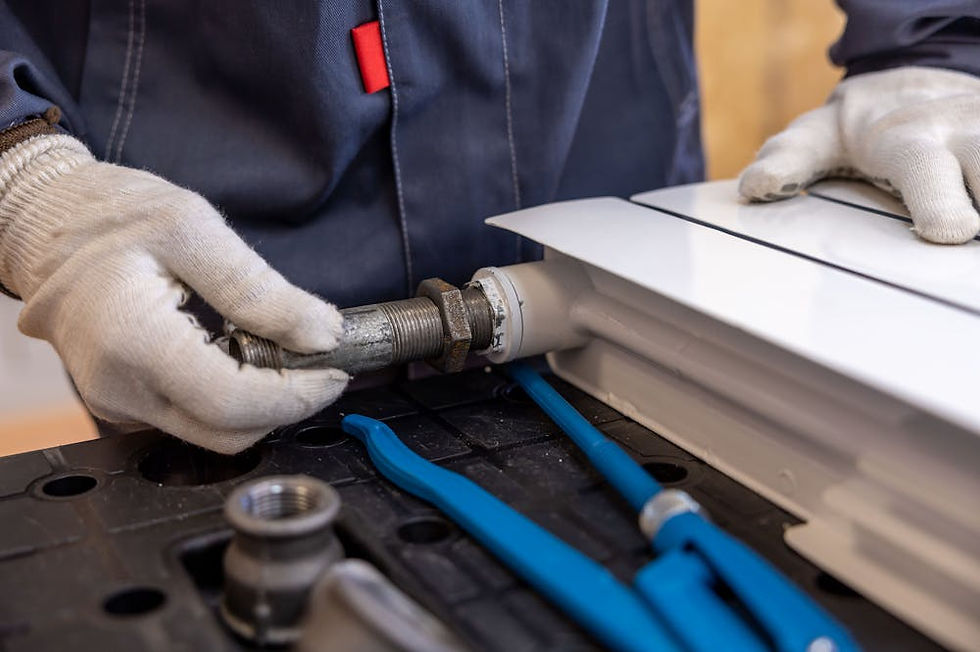10 Essential Tips for Maintaining Hydronic Heating Systems
- Molly Crowe
- Aug 7
- 7 min read
Have you ever wondered why some hydronic heating systems run smoothly for decades whilst others seem to need constant repairs? What's the secret to keeping your home comfortably warm without those dreaded cold spots or unexpected breakdowns? And let's be honest - wouldn't you rather spend your hard-earned money on something more exciting than emergency heating repairs?
If you're nodding along, you're in the right place. Hydronic heating systems are brilliant when they're working properly, but they do need a bit of TLC to keep performing at their best. The good news is that maintaining these systems isn't rocket science - it just takes knowing what to look for and staying on top of a few simple tasks.

In this guide, we'll walk through 10 essential tips that'll help you keep your hydronic heating system running like a dream. From scheduling professional inspections to preparing for seasonal changes, we've got you covered. Whether you're new to hydronic heating or you've had your system for years, these practical tips will save you money, prevent headaches, and keep your home toasty warm all winter long.
1. Schedule Annual Professional Inspections
When Should You Book Your Hydronic Heating Service?
The best time to book your annual hydronic heating service is during autumn, ideally in March or April if you're in Australia. This timing gives you a cushion before the cold weather hits, allowing time for any necessary repairs. Many homeowners make the mistake of waiting until winter, only to find themselves joining a long queue of panicked customers when their heating fails on the first cold morning.
Professional technicians tend to be less busy during autumn, which means you'll likely get a more convenient appointment time and potentially better rates. Plus, if your technician spots any issues, you'll have time to budget for repairs before you actually need the heating. It's a bit like getting your car serviced before a long road trip - much better than breaking down halfway there!
Some savvy homeowners even book their annual service at the same time each year, setting a reminder on their phone or calendar. This way, it becomes part of their routine home maintenance, just like cleaning the gutters or checking smoke alarms.
What Happens During a Professional Inspection?
During a professional inspection, your technician will give your entire system a thorough once-over. They'll start by checking the boiler's combustion efficiency and making sure it's burning fuel safely and effectively. This includes examining the heat exchanger for any signs of damage or corrosion that could lead to dangerous carbon monoxide leaks.
Next, they'll test all safety controls and devices, including pressure relief valves and automatic shut-offs. They'll also check the expansion tank, inspect all visible pipework for leaks or corrosion, and test each radiator or underfloor heating zone to make sure heat is distributing evenly throughout your home.
The technician will also clean key components, adjust system pressure if needed, and check the water quality. They might recommend a system flush if there's significant sludge build-up. At the end of the service, you'll receive a report detailing any issues found and recommendations for keeping your system in top shape.
2. Monitor and Maintain Optimal Water Pressure
How Do You Check Water Pressure in Hydronic Systems?
Checking your system's water pressure is surprisingly straightforward. Most hydronic heating systems have a pressure gauge on or near the boiler - it looks like a small dial with numbers, typically showing pressure in bars or PSI. The ideal pressure for most domestic systems when cold is between 1 and 1.5 bar (or about 15-22 PSI).
To check the pressure accurately, make sure your system has been off for at least an hour so you're getting a cold reading. Simply look at where the needle points on the gauge. Many gauges have a green zone indicating the optimal pressure range, making it even easier to spot if something's amiss.
If your system doesn't have a visible pressure gauge, or if it's tucked away in a hard-to-reach spot, consider asking your technician to install one in a more accessible location during your next service. Being able to quickly check the pressure can help you catch problems early.
Signs Your System Has Pressure Problems
Low pressure is one of the most common issues with hydronic heating systems, and it's usually pretty obvious when it happens. Your radiators might feel cooler than usual, especially those on upper floors. You might also hear gurgling or banging noises as air gets trapped in the system.
High pressure, whilst less common, can be equally problematic. Signs include water dripping from the pressure relief valve (usually a pipe that runs outside your home), radiators feeling extremely hot to touch, or the boiler switching itself off frequently. High pressure puts stress on all system components and can lead to premature failure.
If you notice pressure fluctuations, don't ignore them. Constantly dropping pressure often indicates a leak somewhere in the system, whilst rising pressure might suggest a faulty expansion vessel or filling loop. Both situations need professional attention to prevent more serious damage down the track.
3. Bleed Your Radiators Regularly
How Often Should You Bleed Hydronic Radiators?
The frequency of bleeding your radiators depends on several factors, but as a general rule, checking them at the start of each heating season is a good practice. If you notice cold spots at the top of radiators or hear gurgling sounds when the heating's on, it's definitely time for a bleed.
Some systems are more prone to air build-up than others. Older systems, those that have had recent work done, or systems that have been drained and refilled will likely need more frequent bleeding. If you find yourself bleeding radiators more than a couple of times per heating season, it might indicate a bigger issue that needs investigating.
Many homeowners find it helpful to do a quick check of all radiators when they first switch the heating on for winter. Simply turn the system on, let it run for 15-20 minutes, then feel each radiator from bottom to top. Any that are cooler at the top need bleeding.
Step-by-Step Guide to Bleeding Radiators
Bleeding a radiator is one of those DIY tasks that sounds more complicated than it actually is. First, make sure your heating system is switched off and the radiators have cooled down - this prevents hot water from spurting out when you open the valve.
You'll need a radiator key (available from any hardware store) and an old towel or container to catch drips. Locate the bleed valve - it's usually at the top corner of the radiator. Place your towel underneath, insert the key, and turn it anti-clockwise about a quarter turn. You'll hear a hissing sound as air escapes.
Keep the valve open until water starts to dribble out steadily, then quickly close it by turning clockwise. Don't over-tighten - just enough to stop the water. Once you've bled all necessary radiators, check your system pressure and top up if needed. Job done!
4. Keep Your Boiler in Top Condition
Essential Boiler Maintenance Tasks
Your boiler is the heart of your hydronic heating system, so keeping it happy should be top priority. Beyond annual professional servicing, there are several things you can do to maintain your boiler. Keep the area around it clear and well-ventilated - boilers need to breathe, and clutter can be a fire hazard.
Check the boiler's display panel regularly for error codes or warning lights. Modern boilers are pretty good at telling you when something's wrong, so don't ignore these warnings. Also, listen for unusual noises like banging, whistling, or gurgling, which could indicate problems like limescale build-up or pump issues.
During summer months when the heating's off, run your boiler for 10-15 minutes once a month. This prevents the pump from seizing up and keeps seals lubricated. It's a simple task that can prevent annoying breakdowns when you need the heating most.
Common Boiler Issues to Watch For
One of the most common boiler problems is the pilot light going out on older models. Whilst this might seem like a minor inconvenience, frequent pilot light failures could indicate issues with the thermocouple or gas supply. If you're constantly relighting it, call in a professional.
Boiler lockouts are another frequent issue, where the boiler shuts itself down as a safety measure. This might happen due to low water pressure, overheating, or sensor failures. Most modern boilers will display an error code to help identify the problem. While some issues (like low pressure) you can fix yourself, others require professional attention.
Leaking or dripping around the boiler should never be ignored. Even small leaks can cause significant damage over time and might indicate failing internal components. If you spot any moisture around your boiler, switch it off and call for professional help immediately.
5. Check and Replace System Filters
Why Are Clean Filters Critical for Hydronic Heating?
Clean filters are absolutely vital for maintaining efficiency and prolonging your system's life. Filters trap debris, sludge, and scale that would otherwise circulate through your system, potentially damaging the pump, valves, and heat exchanger. A clogged filter forces your system to work harder, increasing energy bills and wear on components.
Think of it like the oil filter in your car - you wouldn't dream of never changing that, would you? The same principle applies to your heating system. Clean filters mean cleaner water, which translates to better heat transfer, quieter operation, and fewer breakdowns.
Many homeowners don't even realise their system has filters, let alone that they need regular attention. If you're not sure where yours are located or when they were last changed, make this a priority question for your next service visit.
Filter Replacement Schedule and Tips
Most hydronic heating systems have at least one magnetic filter, typically installed near the boiler. These should be checked and cleaned annually as part of your regular service. However, if you live in an area with particularly hard water or have an older system, you might need more frequent cleaning.
Some systems also have inline strainer filters that protect individual components. These simple mesh filters can usually be cleaned rather than replaced, but they do need regular attention. A good rule of thumb is to check them at the start and end of each heating season.
When cleaning or replacing filters, always turn off the system and allow it to cool. Have towels ready to catch any water spillage. If you're not confident doing this yourself, it's perfectly fine to leave it to the professionals - better safe than sorry when dealing with your heating system.
Conclusions
After covering these essential maintenance tips, let's put it all together into a practical schedule you can actually stick to. Think of this as your heating system's fitness routine - regular small efforts that prevent major problems. Start by marking your calendar with the non-negotiables: annual professional service, seasonal radiator bleeding, and monthly summer run-throughs.









Comments